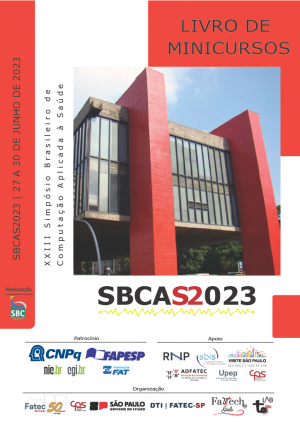Minicursos do XXIII Simpósio Brasileiro de Computação Aplicada à Saúde
Palavras-chave:
SBCAS 2023, Computação Aplicada à Saúde, SBCAS, Minicursos do SBCAS 2023Sinopse
O Livro de Minicursos do SBCAS 2023 traz os textos dos minicursos selecionados e apresentados nesta edição do evento. O livro está organizado em cinco capítulos abordando temas de aprendizado de máquinas, padrões de dados de saúde digital, IoT e telessaúde.
O Capítulo 1, intitulado “Internet das Coisas e Ambientes Inteligentes no contexto da Saúde“, apresenta um estudo sobre a aplicação de Internet das Coisas e ambientes inteligentes dentro do contexto da Saúde.
O Capítulo 2, intitulado “Aprendizado de Máquina Supervisionado para Séries Temporais na Área da Saúde”, apresenta técnicas para lidar com dados temporais para a área da saúde, sob os pontos de vista teórico e prático.
O Capítulo 3, intitulado “Explicando as decisões com IAs: Demonstrando sua aplicação em imagens médicas”, aborda aspectos teóricos para explicar as decisões tomadas pelos modelos de IA, em especial as baseadas em modelos de Redes Neurais Profundas (DNN) e sua importância no contexto médico, apresentando vários métodos de explicação de modelos DNN.
O Capítulo 4, intitulado “Padrões e Soluções para Armazenamento, Compartilhamento e Estruturação de Dados em Saúde Digital: Privacidade, Integração e Desafios”, explora padrões de Electronic Medical Records (EMRs), desafios de segurança e soluções baseadas em cadeia de blocos para interoperabilidade e compartilhamento seguro de dados na área da saúde.
O Capítulo 5, intitulado “Nova Geração da Telessaúde: Oportunidades, Tendências e Desafios”, conclui o livro, levantando as principais e mais novas técnicas computacionais que estão sendo adotadas ou vislumbradas para uso em telessaúde, além de discutir novos projetos de computação aplicados à telessaúde e o posicionamento do Brasil dentro desse cenário.
Capítulos
-
1. Internet das Coisas e Ambientes Inteligentes no contexto da Saúde
-
2. Aprendizado de Máquina Supervisionado para Séries Temporais na Área da Saúde
-
3. Explicando as decisões com IAs: Demonstrando sua aplicação em imagens médicas
-
4. Padrões e Soluções para Armazenamento, Compartilhamento e Estruturação de Dados em Saúde Digital: Privacidade, Integração e Desafios
-
5. Nova Geração da Telessaúde: Oportunidades, Tendências e Desafios
Downloads



